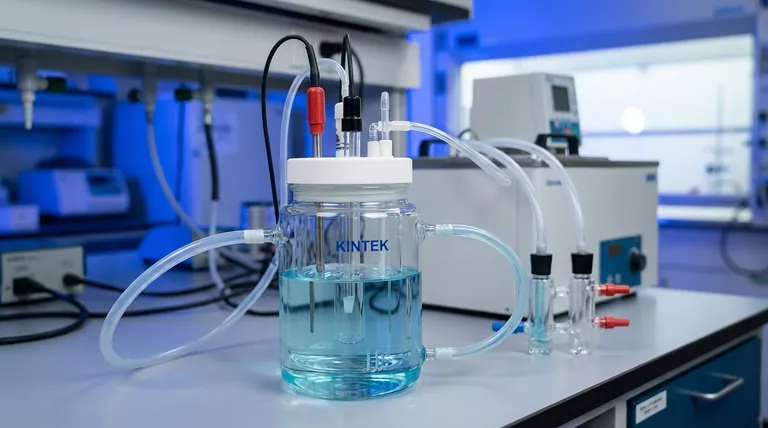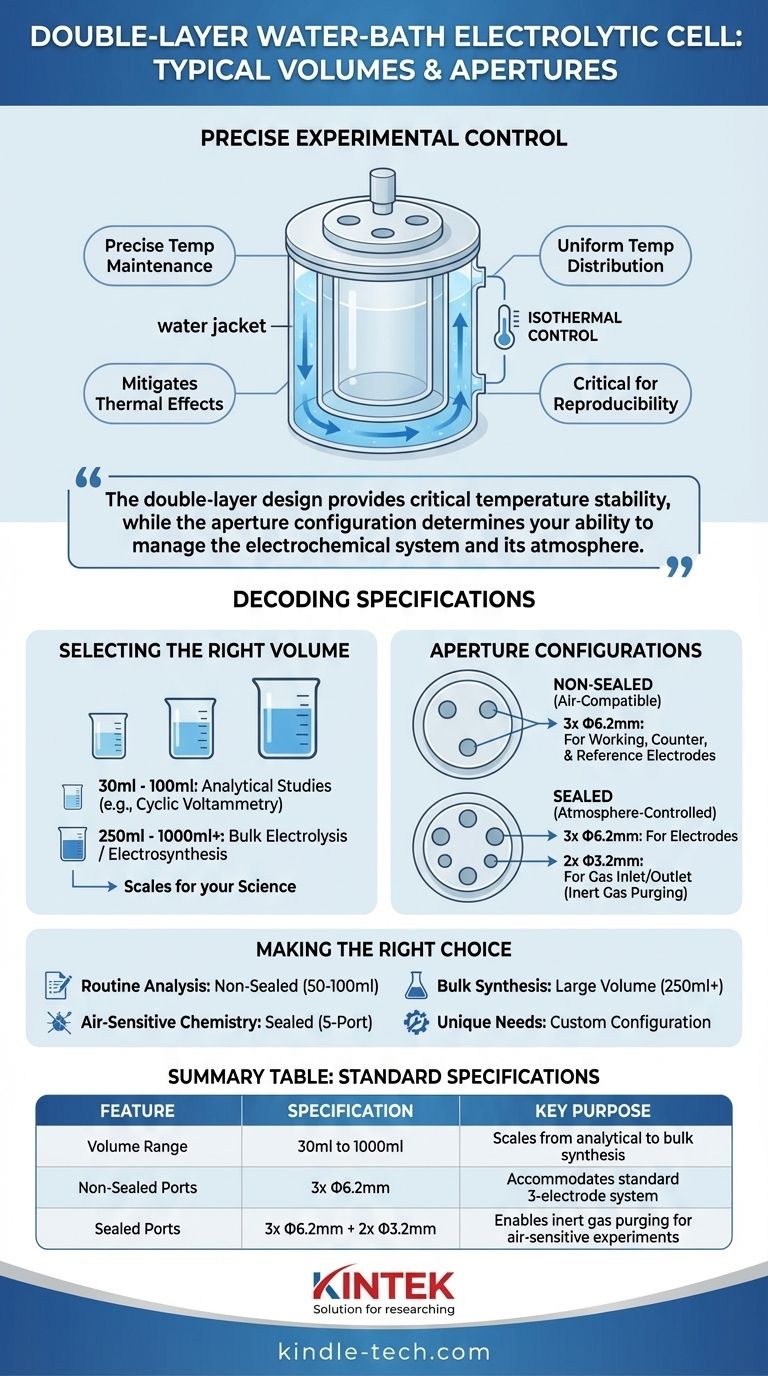To be precise, a standard double-layer water-bath electrolytic cell typically comes in volumes ranging from 30ml to 1000ml. The aperture configuration is designed for a three-electrode system, with a non-sealed version usually having three Φ6.2mm openings and a sealed version having three Φ6.2mm openings plus two smaller Φ3.2mm openings for gas lines.
The choice of an electrolytic cell is not merely about size; it's a strategic decision to control the experimental environment. The double-layer design provides critical temperature stability, while the aperture configuration determines your ability to manage the electrochemical system and its atmosphere.

The Core Function: Why a Double-Layer Design?
A double-layer, or "jacketed," electrolytic cell is fundamentally a tool for isothermal control. It consists of an inner reaction chamber surrounded by an outer jacket through which a temperature-controlled liquid circulates.
The Principle of Isothermal Control
The external water bath allows you to set and maintain a precise temperature inside the inner cell where your reaction occurs. This is critical for the accuracy and repeatability of electrochemical experiments.
Mitigating Thermal Effects
Electrolysis can generate significant heat (Joule heating), and ambient temperature fluctuations can also affect results. The water bath acts as a large thermal buffer, absorbing this excess heat and stabilizing the system.
Ensuring Uniform Temperature Distribution
By surrounding the inner cell, the water bath prevents local hot or cold spots from forming on your electrode surfaces. This uniformity is crucial for achieving consistent reaction rates, improving electrolysis efficiency, and ensuring product consistency.
Decoding Volume and Aperture Specifications
The physical specifications of the cell directly map to the requirements of your experiment, from the scale of the reaction to the type of atmosphere required.
Selecting the Right Volume
The standard volume range for these cells is 30ml to 1000ml. Smaller volumes (e.g., 30-100ml) are ideal for analytical studies, cyclic voltammetry, or when using expensive electrolytes or substrates.
Larger volumes (e.g., 250ml and up) are necessary for bulk electrolysis or preparative electrosynthesis, where the goal is to produce a significant quantity of a product.
The Standard Three-Electrode Aperture Layout
The most common configuration is designed to accommodate a three-electrode system. The three larger Φ6.2mm ports are intended for the working electrode, counter electrode, and reference electrode.
One of these ports is often used for a Luggin capillary to position the reference electrode tip close to the working electrode, minimizing iR drop errors.
Sealed vs. Non-Sealed Configurations
The key difference is atmospheric control. A non-sealed cell is open to the air, which is acceptable for many robust reactions.
A sealed cell adds two smaller Φ3.2mm ports. These are essential for purging the electrolyte with an inert gas (like argon or nitrogen) to remove oxygen for air-sensitive experiments or for introducing gaseous reactants.
Understanding the Trade-offs and Customizations
While standard configurations cover most use cases, understanding their limitations is key to designing a successful experiment.
The Cost of Control (Sealed Systems)
A sealed system provides superior control over the reaction atmosphere, which is non-negotiable for anaerobic electrochemistry. However, it adds complexity to the setup, requiring gas lines, septa, and careful handling to maintain the inert environment.
The Flexibility of Customization
Standard models are only a starting point. Manufacturers can typically customize both volume and aperture arrangements. This allows you to add extra ports for things like a salt bridge, a separate thermometer, or dedicated tubes for sparging gas through the solution.
Material Considerations
While most double-layer cells are made of glass, specialized applications might demand other materials. For experiments involving corrosive substances like hydrofluoric acid, an all-PTFE cell would be required, which comes with its own set of standard volumes and configurations.
Making the Right Choice for Your Experiment
Selecting the correct cell is about matching its features to your scientific objective.
- If your primary focus is routine electrochemical analysis: A standard non-sealed cell (50-100ml) with three Φ6.2mm ports is a robust and versatile starting point.
- If your primary focus is air-sensitive or anaerobic chemistry: You must use a sealed cell with the five-port configuration (3x Φ6.2mm, 2x Φ3.2mm) to enable inert gas purging.
- If your primary focus is bulk electrosynthesis: A larger volume cell (250ml+) is necessary to accommodate the required quantity of reactants and electrolyte.
- If you have unique geometric or equipment constraints: You should request a custom configuration to ensure proper fit and function for all your components.
Ultimately, the right electrolytic cell is the one that gives you precise control over the variables that matter most in your investigation.
Summary Table:
| Feature | Standard Specification | Key Purpose |
|---|---|---|
| Volume Range | 30ml to 1000ml | Scales from analytical studies to bulk synthesis |
| Non-Sealed Ports | 3 x Φ6.2mm openings | Accommodates standard 3-electrode system (working, counter, reference) |
| Sealed Ports | 3 x Φ6.2mm + 2 x Φ3.2mm openings | Enables inert gas purging for air-sensitive experiments |
Ready to achieve precise temperature and atmospheric control in your electrochemical experiments?
KINTEK specializes in high-quality lab equipment, including a range of double-layer water-bath electrolytic cells designed for accuracy and repeatability. Whether you need a standard configuration for routine analysis or a custom solution for specialized research, our expertise ensures you get the right tool for your needs.
Contact us today to discuss your specific requirements and let our team help you optimize your lab's capabilities. Get in touch now!
Visual Guide

Related Products
- Double-Layer Water Bath Electrolytic Electrochemical Cell
- Double Layer Five-Port Water Bath Electrolytic Electrochemical Cell
- H-Type Double-Layer Optical Electrolytic Electrochemical Cell with Water Bath
- Electrolytic Electrochemical Cell with Five-Port
- Multifunctional Electrolytic Electrochemical Cell Water Bath Single Layer Double Layer
People Also Ask
- How can water and gas leaks be prevented in a double-layer water-bath electrolytic cell? A Guide to Proactive Maintenance
- What are the procedures for after using a double-layer water-bath electrolytic cell? Ensure Equipment Longevity and Data Accuracy
- What is the overall structure of the H-type double-layer optical water bath electrolytic cell? Precision Design for Controlled Experiments
- When is professional repair required for a double-layer water-bath electrolytic cell? Protect Your Lab's Precision and Safety
- What does the routine maintenance of a double-layer water-bath electrolytic cell involve? A Guide to Ensuring Precision and Longevity



















